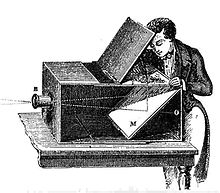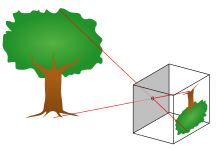Igwefoto gbara ọchịchịrị


Igwefoto obscura (pl. camerae obscurae ma ọ bụ igwefoto obscuras; sitere na igwefoto Latin obscūra ''ọchịchịrị chamber') bụ ọnụ ụlọ gbara ọchịchịrị nke nwere obere oghere ma ọ bụ oghere n'otu akụkụ..site na nke a na-atụnye ihe oyiyi n'elu mgbidi ma ọ bụ tebụl chere oghere ahụ. A na-akpọkwa onyonyo (ma ọ bụ ụkpụrụ nke ntule ya) nke obscuras igwefoto na-enweghị oghere dị ka “onyinyo pinhole.
Camera obscura nwekwara ike izo aka na ihe owuwu yiri ya dị ka igbe ma ọ bụ ụlọikwuu nke a na-ese onyinyo mpụga n'ime. A na-eji igwefoto obscuras nwere oghere n'ime oghere kemgbe ọkara nke abụọ nke narị afọ nke iri na isii wee bụrụ ihe a ma ama dị ka ihe enyemaka maka ise ihe na ise ihe. E mepụtara echiche ahụ n'ime igwefoto foto na ọkara mbụ nke narị afọ nke iri na itoolu, mgbe ejiri igbe igwefoto mee ihe iji kpughere ihe ndị na-anụ ọkụ na onyinyo ahụ.
A na-eji igwefoto obscura eme ihe iji mụọ eclipses na-enweghị ihe ize ndụ nke imebi anya site na ile anya n'ime anyanwụ. Dị ka ihe enyemaka na-ese ihe, ọ na-enye ohere ịchọpụta onyinyo ahụ a tụrụ anya ya iji mepụta ihe ngosi ziri ezi, a na-enwekwa ekele karịsịa dị ka ụzọ dị mfe iji nweta ọhụụ eserese kwesịrị ekwesị.
Tupu [1] jiri okwu camera obscurum mee ihe na 1604, a na-eji okwu ndị ọzọ na-ezo aka na ngwaọrụ ndị ahụ: cubiculum obscurum, cubiculum tenebricosum, conclave obscurum na locus obscurus.
A na-akpọ igwefoto obscura na-enweghị oghere ma nwee obere oghere mgbe ụfọdụ dị ka igwefoto pinhole, ọ bụ ezie na nke a na-ezo aka na igwefoto na-enweghị anya dị mfe (ụlọ) ebe a na-eji ihe nkiri foto ma ọ bụ akwụkwọ foto.
Nkọwa anụ ahụ
[dezie | dezie ebe o si]Ìhè na-aga n'ahịrị kwụ ọtọ ma na-agbanwe mgbe ihe na-egosipụta ha ma na-amịkọrọ ha, na-ejigide ozi gbasara agba na ìhè nke elu ihe ahụ. Ihe ndị na-enwu gbaa na-egosipụta ụzarị ìhè n'akụkụ niile. Obere oghere [2] n'ime ihe mgbochi na-anabata naanị ụzarị nke na-aga kpọmkwem site n'ebe dị iche iche n'akụkụ nke ọzọ, ụzarị ndị a na-emepụta onyinyo nke ebe ahụ ebe ha ruru n'elu nke megidere oghere ahụ.
lens" data-linkid="35" href="./Human_eye" id="mwRg" rel="mw:WikiLink" title="Human eye">Anya mmadụ (na nke ọtụtụ anụmanụ ndị ọzọ) na-arụ ọrụ dị ka igwefoto gbara ọchịchịrị, na ụzarị nke ìhè na-abanye n'oghere (nwa akwụkwọ), na-elekwasị anya na oghere anya ma na-agafe ụlọ gbara ọchịchukwu tupu ọ mepụta onyinyo a tụgharịrị atụgharị n'elu ihe dị larị (retina). Ihe atụ ahụ pụtara na mmalite narị afọ nke iri na isii ma na narị afọ nke asaa ga-ahụkarị iji gosipụta echiche nkà mmụta okpukpe ọdịda anyanwụ banyere Chineke na-eke eluigwe na ala dị ka igwe, nwere ebumnuche a kara aka (dị ka ụmụ mmadụ na-emepụta igwe). Nke a nwere mmetụta dị ukwuu na sayensị omume, ọkachasị na ọmụmụ nke nghọta na nghọta. [3]'ọnọdụ a, ọ bụ ihe ịrịba ama na ngosipụta nke ihe oyiyi a tụgharịrị atụgharị bụ n'ezie ụkpụrụ anụ ahụ nke anya nke na-ebute mmalite nke ndụ (kama ihe e mepụtara ma ọ bụ teknụzụ) ma ọ bụghị ihe e ji mara ọhụụ niile nke ihe ndị dị ndụ.
Teknụzụ
[dezie | dezie ebe o si]
Igwefoto obscura nwere igbe, ụlọikwuu, ma ọ bụ ọnụ ụlọ nwere obere oghere n'otu akụkụ ma ọ bụ n'elu. Ìhè sitere [4]'ebe dị n'èzí na-agafe n'ime oghere ahụ ma kụọ n'ime, ebe a na-emegharị ihe nkiri ahụ, tụgharịa ya (n'elu ala) ma tụgharịa ya azụ (n'aka ekpe gaa n'aka nri), mana echekwara agba na ọhụụ.
Iji mepụta onyinyo doro anya, oghere ahụ na-adịkarị obere karịa 1/100 nke anya na ihuenyo ahụ.Ka a na-eme ka oghere ahụ dị obere, onyinyo ahụ na-akawanye nkọ, mana ọ na-adịwanye njọ. N'inwe obere oghere, ịdị nkọ na-efu n'ihi diffraction. [5] na-enweta ịdị nkọ kachasị mma site na oghere oghere nke fọrọ nke nta ka ọ bụrụ nke hà nhata na geometric nkezi ogologo nke ìhè na anya dị na ihuenyo.
[2]'omume, igwefoto obscuras na-eji oghere anya karịa pinhole n'ihi na ọ na-enye ohere oghere buru ibu, na-enye ìhè a na-eji eme ihe mgbe ị na-elekwasị anya.
Ọ bụrụ na ejide onyinyo ahụ na ihuenyo translucent, enwere ike ile ya anya site n'azụ ka ọ ghara ịlaghachi azụ (ma ka na-eche ihu). N'iji enyo, ọ ga-ekwe omume ịmepụta onyinyo dị n'akụkụ aka nri. A pụkwara igosi ihe ngosi ahụ n'elu ala (dịka, tebụl). Ụdị elu nke [2] afọ nke iri na asatọ n'ime ụlọikwuu jiri enyo n'ime ụdị periscope n'elu ụlọikwuu ahụ.
Ụdị igwefoto obscura nke igbe na-enwekarị enyo dị n'akụkụ nke na-egosipụta onyinyo kwụ ọtọ na akwụkwọ na-agbaso nke a na-etinye n'elu iko ya. [6] bụ ezie na a na-ele onyinyo ahụ anya site n'azụ, enyo ahụ na-atụgharị ya.
Akụkọ ihe mere eme
[dezie | dezie ebe o si]Prehistory ruo 500 BC: Ihe nwere ike ime ka nka prehistoric na o nwere ike iji ya mee ihe n'ememe okpukpe, gnomons
[dezie | dezie ebe o si]E nwere echiche na ihe omume nke mmetụta igwefoto obscura (site na obere oghere n'ụlọikwuu ma ọ bụ na ihuenyo nke akpụkpọ anụ) sitere n'ike mmụọ nsọ Paleolithic cave paintings. Mgbagwoju a[7] n'ọdịdị anụmanụ n'ọtụtụ ihe osise ọgba paleolithic nwere ike ịbụ n'ike mmụọ nsọ site na mgbagwoju anya a hụrụ mgbe elu ebe a na-ese onyinyo abụghị nke kwụ ọtọ ma ọ bụ na ọ bụghị n'akụkụ ziri ezi.[8][9] na-atụkwa aro na ihe osise igwefoto obscura nwere ike ịrụ ọrụ na ihe owuwu Neolithic.

A kọwara gnomons ndị e gwuru oghere na-egosipụta onyinyo nke anyanwụ n'ihe odide Zhoubi Suanjing nke China (1046 BC-256 BC na ihe agbakwunyere ruo n'ihe dị ka 220 AD). [10] Enwere ike ịlele ebe okirikiri na-egbuke egbuke dị iji kọwaa oge nke ụbọchị na afọ. [11]'ọdịbendị ndị Arab na ndị Europe, e mechara kwuo na ọ bụ onye Egypt na-enyocha mbara igwe na onye na-eme mgbakọ na mwepụ bụ Ibn Yunus mepụtara ya n'ihe dị ka 1000 AD.
500 BC ruo 500 AD: Ihe odide mbụ
[dezie | dezie ebe o si]
Otu n'ime ihe odide mbụ a maara banyere ihe oyiyi pinhole dị n'ihe odide Ndị China a na-akpọ Mozi_(book)" id="mwiA" rel="mw:WikiLink" title="Mozi (book)">Mozi, nke e dere na narị afọ nke anọ BC, nke a na-ekwu na ọ bụ Mozi (ihe dị ka 470 BC-ihe dị ka 391 BC), onye ọkà ihe ọmụma China na onye guzobere Mohist School of Logic . [12] Ihe odide ndị a na-akọwa etu onyinyo ahụ dị na "ebe nchịkọta" ma ọ bụ "ụlọ akụ"[ihe odide 1] si gbanwee site na ebe nkwụsị (pinhole) nke na-anakọta (ìhè) ìhè. Ìhè na-abịa site na ụkwụ nke onye na-enwu gbaa na-ezobe n'okpuru (ya bụ, kụọ n'okpuru pinhole) ma mepụta n'elu onyinyo ahụ. [13][14] na-ezobe ụzarị si n'isi n'elu (ya bụ, kụọ n'elu pinhole) ma mepụta akụkụ dị ala nke onyinyo ahụ.
Akụkọ ọzọ sitere n'aka Onye ọkà ihe ọmụma Gris bụ Aristotle (384-322 BC), ma ọ bụ ikekwe onye na-eso ụzọ echiche ya. [12] ka onye ọkà mmụta sayensị Arab nke narị afọ nke iri na otu bụ Alhazen, a na-eche na Aristotle jiri igwefoto obscura mee ihe maka ịhụ chi jiri n'ehihie. A na-emetụta mmepụta nke ihe oyiyi pinhole dị ka isiokwu n'ọrụ Nsogbu - Akwụkwọ XV, na-ajụ: N'ịgbalị ịkọwa ihe omume ahụ, onye edemede ahụ kọwara otú ìhè ahụ si mepụta cones abụọ; otu n'etiti Anyanwụ na oghere na otu n'ime oghere na ụwa. Otú [15] dị, a na-ekwu na gburugburu nke onyinyo ahụ bụ n'ihi echiche ahụ bụ na akụkụ nke ụzarị ọkụ (nke a na-eche na ọ na-aga n'ahịrị kwụ ọtọ) na-ebibi na nkuku dị na oghere ahụ na-eme ka ọ ghara ịdị ike nke na a pụghị ịhụ ha.
Ọtụtụ ndị ọkà ihe ọmụma na ndị ọkà mmụta sayensị nke ụwa ọdịda anyanwụ ga-atụle esemokwu dị n'etiti ìhè na-aga n'ahịrị kwụ ọtọ na mmepụta nke ntụpọ dị gburugburu nke ìhè n'azụ oghere dị iche iche, ruo mgbe ọ ghọrọ ihe a nabatara n'ozuzu na ụdị okirikiri na nke a kọwara na "nsogbu" bụ ihe oyiyi pinhole nke anyanwụ.
[16]'akwụkwọ ya Optics (ihe dị ka 300 BC, nke dị ndụ n'ihe odide ndị ọzọ site na 1000 AD), Euclid tụrụ aro nkọwa mgbakọ na mwepụ nke ọhụụ na "ahịrị ndị sitere n'Anya na-agafe kpọmkwem na oghere dị ukwuu" na "ụdị oghere dị n'ọhụụ anyị bụ cone, ya na elu ya na anya na ntọala ya na njedebe nke ọhụụ anyị. " [17] Nsụgharị ederede ahụ, dị ka Ignazio Danti'afọ 1573, ga-agbakwunye nkọwa nke ụkpụrụ igwefoto obscura iji gosipụta echiche Euclid.
500 ruo 1000: Nnyocha mbụ, ọmụmụ nke ìhè
[dezie | dezie ebe o si]
narị afọ nke isii, onye Byzantine-Grik na-eme mgbakọ na mwepụ na onye na-ese ụkpụrụ ụlọ Anthemius nke Tralles (nke a ma ama dị ka onye na-ewu ụlọ nke Hagia Sophia) nwalere mmetụta metụtara igwefoto obscura. Anthemius nwere nghọta [18] mgbagwoju anya banyere ihe ndị metụtara anya, dịka eserese ìhè ọ rụrụ na 555 AD gosipụtara.
[15]'akwụkwọ ya bụ De Aspectibus, Al-Kindi (ihe dị ka 801-873) dere banyere ihe oyiyi pinhole iji gosipụta na ìhè na-aga n'ahịrị kwụ ọtọ.
[19] narị afọ nke iri, Yu Chao-Lung na-eche na ọ na-ese onyinyo nke ụdị pagoda site na obere oghere n'elu ihuenyo iji mụọ ntụziaka na ọdịiche nke ụzarị ọkụ.
1000 ruo 1400: Ngwá ọrụ anya na nke mbara igwe, ntụrụndụ
[dezie | dezie ebe o si]

Onye Arab physicist Ibn al-Haytham (nke Latinised Alhazen maara na West) (965-1040) mụrụ nke ọma ihe igwefoto obscura na mmalite narị afọ nke iri na otu.
[21][22]'akwụkwọ ya "On the shape of the eclipse" o nyere nyocha mbụ na mgbakọ na mwepụ nke ihe omume ahụ. [23] ghọtara mmekọrịta dị n'etiti Ebe a na-elekwasị anya na pinhole.
Ọ bụ ezie na a maara ụkpụrụ teknụzụ nke igwefoto obscura kemgbe oge ochie, ojiji sara mbara nke echiche teknụzụ na-emepụta ihe oyiyi na-ahụ anya na eserese, map, nhazi ihe nkiri, na ihe owuwu, na, mgbe e mesịrị, foto na ihe nkiri malitere na Western Renaissance na mgbanwe sayensị. bụ ezie na Alhazen (Ibn al-Haytham) ahụlarị mmetụta anya ma mepụta echiche mbụ nke refraction nke ìhè, o nweghị mmasị na ya ịmepụta ihe oyiyi (iji ya tụnyere Hans Belting 2005); ọha mmadụ ọ bi na ya bụ ọbụna onye iro (iji ya atụnyere Aniconism na Islam) maka ihe oyiyi onwe onye.
N'afọ 1827, onye nkatọ Vergnaud mere mkpesa banyere ojiji a na-ejikarị igwefoto obscura eme ihe n'ịmepụta ọtụtụ ihe osise na ngosi Salon nke afọ ahụ na Paris: "Ọ bụ ọha na eze ka a ga-ata ụta, ndị na-ese ihe, ma ọ bụ ndị ọka ikpe, mgbe a na-achụ ihe osise akụkọ ihe mere eme, na ụdị ihe osise, na nke ahụ!... nke igwefoto obscur. " [24] (nke a sụgharịrị site na French)
Onye Britain [25]-ese foto Richard Learoyd bụ ọkachamara n'iji igwefoto obscura mee foto nke ụdị ya na ihe ndị ọ na-ese n'oge a kama iji igwefoto ọgbara ọhụrụ, na-ejikọta ya na usoro ilfochrome nke na-emepụta nnukwu mbipụta na-enweghị mkpụrụ. [26]
Ndị ọzọ [27]-ese ihe n'oge a bụ ndị jiri igwefoto obscura mee ihe n'ụzọ doro anya na ọrụ ha gụnyere James Turrell, Abelardo Morell, Minnie Weisz, Robert Calafiore, Vera Lutter, Marja Pirilä, na Shi Guorui.
Igwefoto dijitalụ
[dezie | dezie ebe o si]
Cam[28] obscura ụkpụrụ pinhole ebumnuche ndị e ji Aluminium mee dị n'ahịa. Dị ka ìhè nke onyinyo ahụ adịghị ike na ihe omume ahụ, a ghaghị iji ogologo oge ngosi ma ọ bụ mmetụta dị elu na foto dijitalụ. Ihe oyiyi ahụ na-apụta na ya nwere ọdịdị gbara ọchịchịrị na ihe oyiyi ahụ abụghị nke dị nkọ, ọbụna ebumnuche ahụ na-agbakwunye na ọnọdụ nke igwefoto nka.
Edensibia
[dezie | dezie ebe o si]- ↑ Phelps Gage (1914). Optic projection, principles, installation, and use of the magic lantern, projection microscope, reflecting lantern, moving picture machine. Comstock Publishing Company. “obscurum cubiculum.”
- ↑ 2.0 2.1 2.2 Standage (1773). "The Camera Obscura: Its Uses, Action, and Construction", Amateur work, illustrated, 67–71. Retrieved on 11 January 2021. Kpọpụta njehie: Invalid
<ref>tag; name "amateur work" defined multiple times with different content - ↑ Stoffregen (October 2013). "On the Physical Origins of Inverted Optic Images" (in en). Ecological Psychology 25 (4): 369–382. DOI:10.1080/10407413.2013.839896. ISSN 1040-7413. Retrieved on 17 September 2023.
- ↑ Melvin Lawrence DeFleur, and Sandra Ball-Rokeach (1989). Theories of Mass Communication, 5, Longman. ISBN 9780801300073. Retrieved on 11 January 2021.
- ↑ Heinrich F. Beyer and Viateheslav P. Shevelko (2016). Introduction to the Physics of Highly Charged Ions. CRC Press. ISBN 9781420034097. Retrieved on 11 January 2021.
- ↑ Steadman (2002). Vermeer's Camera: Uncovering the Truth Behind the Masterpieces. Oxford University Press. ISBN 9780192803023. Retrieved on 11 January 2021.
- ↑ Paleolithic. paleo-camera. Archived from the original on 12 November 2018. Retrieved on 2 May 2017.
- ↑ Jennifer Ouellette (29 June 2016). deadspin-quote-carrot-aligned-w-bgr-2. Gizmodo. Archived from the original on 18 September 2017. Retrieved on 9 September 2017.
- ↑ Neolithic. paleo-camera. Archived from the original on 2 December 2017. Retrieved on 2 May 2017.
- ↑ Boulger (1969). The Asiatic Review. Retrieved on 16 September 2020.
- ↑ Rohr (2012). Sundials: History, Theory, and Practice. Courier Corporation. ISBN 978-0-486-15170-0. Retrieved on 20 December 2019.
- ↑ 12.0 12.1 Needham. Science and Civilization in China, vol. IV, part 1: Physics and Physical Technology. Retrieved on 5 September 2016. Kpọpụta njehie: Invalid
<ref>tag; name "needham4 98" defined multiple times with different content - ↑ Ruffles (2004). Ghost Images: Cinema of the Afterlife. McFarland, 15–17. ISBN 9780786420056. Retrieved on 9 November 2020.
- ↑ Ancient Greece. paleo-camera (9 March 2010). Archived from the original on 1 November 2018. Retrieved on 5 September 2016.
- ↑ 15.0 15.1 Lindberg (1968). "The Theory of Pinhole Images from Antiquity to the Thirteenth Century". Archive for History of Exact Sciences 5 (2): 154–176. ISSN 0003-9519. Retrieved on 17 September 2023. Kpọpụta njehie: Invalid
<ref>tag; name "lindberg" defined multiple times with different content - ↑ Kleine Geschichte der Lochkamera oder Camera Obscura (de). Archived from the original on 11 November 2018. Retrieved on 9 September 2016.
- ↑ Optics of Euclid.
- ↑ Renner (2012). Pinhole Photography: From Historic Technique to Digital Application. Retrieved on 11 February 2017.
- ↑ Hammond (1981). The camera obscura: a chronicle. Taylor & Francis. ISBN 9780852744512. Retrieved on 16 September 2020.
- ↑ Kirkpatrick (2007). "Light", Physics: A World View, 6, Belmont, California: Thomson Brooks/Cole, 339. ISBN 978-0-495-01088-3.
- ↑ Needham. Science and Civilization in China, vol. IV, part 1: Physics and Physical Technology. Retrieved on 5 September 2016. “it seems that, like Shen Kua, he had predecessors in its study, since he did not claim it as any new finding of his own. But his treatment of it was competently geometrical and quantitative for the first time.”
- ↑ Raynaud (2016). A Critical Edition of Ibn al-Haytham's On the Shape of the Eclipse. The First Experimental Study of the Camera Obscura. New York: Springer International.
- ↑ Needham. Science and Civilization in China, vol. IV, part 1: Physics and Physical Technology. Retrieved on 5 September 2016. “The genius of Shen Kua's insight into the relation of focal point and pinhole can better be appreciated when we read in Singer that this was first understood in Europe by Leonardo da Vinci (+ 1452 to + 1519), almost five hundred years later. A diagram showing the relation occurs in the Codice Atlantico, Leonardo thought that the lens of the eye reversed the pinhole effect, so that the image did not appear inverted on the retina; though in fact it does. Actually, the analogy of focal-point and pin-point must have been understood by Ibn al-Haitham, who died just about the time when Shen Kua was born.”
- ↑ Pinson (2003-07-01). "Daguerre, expérimentateur du visuel" (in fr). Études photographiques (13): 110–135. ISSN 1270-9050. Retrieved on 10 April 2020.
- ↑ Photography Without Negatives (3 November 2014). Archived from the original on 20 December 2021. Retrieved on 20 December 2021.
- ↑ Exuberant and tragic poppies: An interview with Richard Learoyd. Archived from the original on 19 December 2021. Retrieved on 19 December 2021.
- ↑ Contemporary Photographers and the Camera Obscura. I Require Art (14 February 2019). Archived from the original on 18 January 2022. Retrieved on 2022-01-17.
- ↑ Pinhole Lens. Thingyfy. Archived from the original on 4 June 2023. Retrieved on 2023-10-24.
Ebe e si nweta ya
[dezie | dezie ebe o si]- Hill, Donald R. (1993), "Islamic Science and Engineering", Edinburgh University Press, peeji nke 70.
- Lindberg, D.C. (1976), "Theories of Vision from Al Kindi to Kepler", The University of Chicago Press, Chicago and London.
- Nazeef, Mustapha (1940), "Ibn Al-Haitham As a Naturalist Scientist", (n'asụsụ Arabic) , bipụtara ihe omume nke Memorial Gathering of Al-Hacan Ibn Al-Haatham, 21 Disemba 1939, Egypt Printing.
- [Ihe e dere n'ala ala peeji] Sayensị na Mmepeanya na China: Mpịakọta 4, Physics na Physical Technology, Akụkụ 1, Physics. Taipei: Caves Books Ltd.
- Omar, S.B. (1977). "Ibn al-Haitham's Optics", Bibliotheca Islamica, Chicago.
- Lefèvre, Wolfgang (ed.) Inside the Camera Obscura: Optics and Art under the Spell of the Projected Image. Max Planck Institut Fur Wissenschaftgesichte. Max Planck Institute for the History of Science [1]
- Burkhard Walther, Przemek Zajfert: Camera Obscura Heidelberg. Foto ojii na-acha ọcha na ederede. Akwụkwọ akụkọ ihe mere eme na nke oge a. mbipụta merid, Stuttgart, 2006,
Njikọ mpụga
[dezie | dezie ebe o si]- Mgbasa ozi metụtaraIgwefoto gbara ọchịchịrịna Wikimedia Commons

